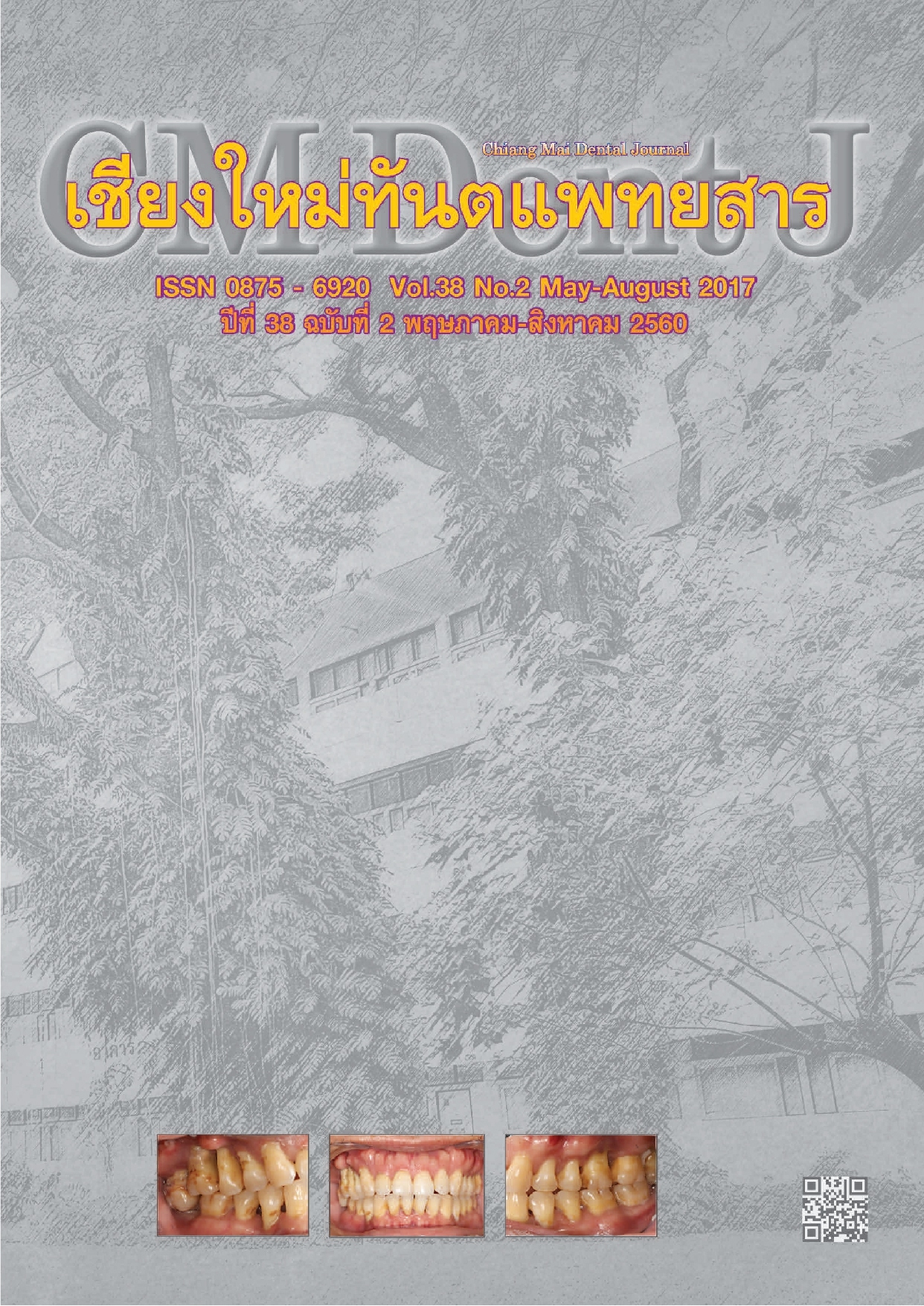Effect of Eugenol-containing Temporary Cement on Pulpal Blood Flow after Full Crown Preparation
Main Article Content
Abstract
Objective: To determine the effect of eugenol-containing temporary cement on pulpal blood flow (PBF) after full crown preparation in human subjects.
Materials and Methods: The experiments were carried out on 20 mandibular second premolars prepared for abutments of fixed bridges. Crown preparation was made using an air-rotor hand-piece with water-spray under local anesthesia. The temporary bridges were cemented with eugenol-containing temporary cement (Group I) or non-eugenol temporary cement (Group II). PBF was recorded with a laser Doppler flow meter (LDF) after complete crown preparation (day 0), one day (day 1) and seven days (day 7) after temporary cementation. The data were normalized to 100 to produce baseline values.
Results: In Group II, the adjusted PBF values recorded on day7 were significantly higher than those on day 1 and day 0 (p < 0.05, Two-way RM ANOVA). The adjusted PBF values recorded on day 7 in Group II were significantly higher than those in Group I. No significant differences were found between each condition in Group I.
Conclusions: There was no change in pulpal blood flow within a week when cementation was with eugenol-containing temporary cement, indicating that no pulpal inflammation was observed.
Article Details
References
Hume WR. An analysis of the release and the diffusion through dentin of eugenol from zinc oxide-eugenol mixtures. J Dent Res 1984;63(6):881-884.
Yap AU, Shah KC, Loh ET, Sim SS, Tan CC. Influence of eugenol-containing temporary restorations on bond strength of composite to dentin. Oper Dent 2001;26(6):556-561.
Fujisawa S, Kadoma Y. Action of eugenol as a retarder against polymerization of methymethacrylate by benzoyl peroxide. Biomaterials 1997;18(9):701-703.
Gazelius B, Olgart L, Edwall B, Edwall L. Non-invasive recording of blood flow in human dental pulp. Endod Dent Traumatol 1986;2(5):219-221.
Matthews B, Vongsavan N. Advantages and limitations of laser Doppler flow meters. Int Endod J 1993;26(1):9-10.
Soo-ampon S, Vongsavan N, Soo-ampon M, Chuckpaiwong S, Matthews B. The sources of laser Doppler blood-flow signals recorded from human teeth. Arch Oral Biol 2003;48(5):353-360.
Vongsavan N, Matthews B. Experiments on extracted teeth into the validity of using laser Doppler techniques for recording pulpal blood flow. Arch Oral Biol 1993;38(5):431-439.
Vongsavan N, Matthews B. Some aspects of the use of laser Doppler flow meters for recording tissue blood flow. Exp Physiol 1993;78(1):1-14.
Bergenholtz G, Nyman S. Endodontic complications following periodontal and prosthetic treatment of patients with advanced periodontal disease. J Periodontol 1984;55(2):63-68.
Jackson CR, Skidmore AE, Ted-Rice R. Pulpal evaluation of teeth restored with fixed prostheses. J Prosthet Dent 1992;67(3):323-325.
Cheung GSP, Lai SCN, Ng RPY. Fate of vital pulps beneath a metal-ceramic crown or a bridge retainer. Int Endod J 2005;38(8):521-530.
Langeland K, Langeland LK. Pulp reactions to crown preparation, impression temporary crown fixation, and permanent cementation. J Prosthet Dent 1965;15(1):129-143.
Seltzer S, Bender IB. Early human pulp reactions to full crown preparations. J Am Dent Assoc 1959;59:915-923.
Stanley HR, Swerdlow H. Biological effects of various cutting methods in cavity preparation: the part pressure plays in pulpal response. J Am Dent Assoc 1960;61:450-456.
Cox ST Jr, Hembree JH Jr, McKnight JP. The bactericidal potential of various endodontic materials for primary teeth. Oral Surg Oral Med Oral Pathol 1978;45(6):947-954.
Cobankara FK, Altinöz HC, Ergani O, Kav K, Belli S. In vitro antibacterial activities of root-canal sealers by using two different methods. J Endod 2004;30(1):57-60.
Anuj G, Sanjay S. Eugenol: a potential phytochemical with multifaceted therapeutic activities. Pharmacologyonline 2 2010;2:108-120.
Glass RL, Zander HA. Pulp healing. J Dent Res 1949;28(2):97-107.
Azuma Y, Ozasa N, Ueda Y, Takagi N. Pharmacological studies on the anti-inflammatory action of phenolic compounds. J Dent Res 1986;65(1):53-56.
Abou Hashieh I, Camps J, Dejou J, Franquin JC. Eugenol diffusion through dentin related to dentin hydraulic conductance. Dent Mater 1998;14(4):229-236.
Lewinstein I, Fuhrer N, Gelfand K, Cardash H, Pilo R. Retention, marginal leakage, and cement solubility of provisional crowns cemented with temporary cement containing stannous fluoride. Int J Prosthodont 2003;16(2):189-193.
Goldman M, Laosonthorn P, White RR. Microleakage--Full crowns and the dental pulp. J Endod 1992;18(10):473-475.
Terata R, Nakashima K, Obara M, Kubota M. Characterization of enamel and dentin surfaces after removal of temporary cement—effect of temporary cement on tensile bond strength of resin luting cement. Dent Mater J 1994;13(2):148-154.
Woody TL, Davis RD. The effect of eugenol-containing and eugenol-free temporary cements on microleakage in resin bonded restorations. Oper Dent 1992;17(5):175-180.


